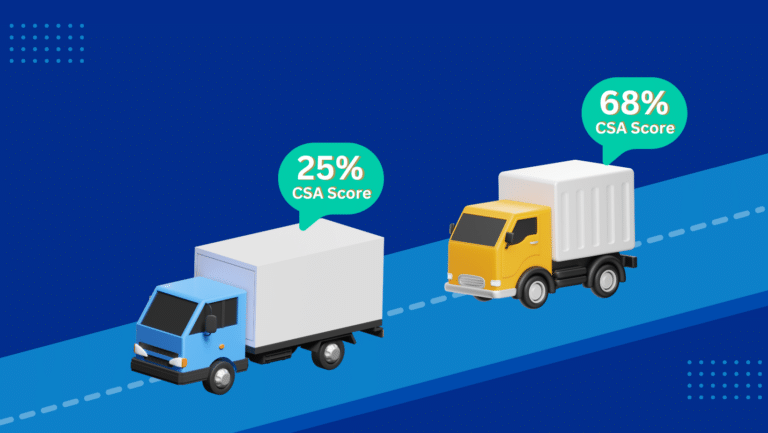Fleet Management Solutions to Improve Driver Behavior in 2024

From enhanced safety, improved driver behavior, and reduced operational costs, fleet management offers numerous benefits to commercial fleets of all types and sizes. Combined with the right technologies and systems, the best fleet management solutions provide actionable data to help improve overall fleet performance.
5 Fleet Management Solutions to Implement in Your Business
It’s no surprise that distracted driving, fatigue, and impaired driving are leading causes of accidents. According to a study by the NHSA, a staggering 90% of accidents result from human error.
Monitoring driving behavior through fleet management technology allows for the early identification of risky driving patterns. By addressing these behaviors promptly, fleet managers can proactively reduce the risk of accidents, creating a safer environment for both drivers and other road users.
According to a survey by Verizon, companies that implement fleet management technologies see a 43% reduction in accidents.
In this blog, we will explore 5 effective fleet management solutions that help companies proactively mitigate the risk of accidents and detect unsafe driving behavior.
1. Advanced driver assistance systems (ADAS)
ADAS encompasses a variety of fleet management technologies designed to enhance vehicle safety and improve the driving experience. For example, ADAS technologies, such as Automatic Emergency Braking (AEB) and Forward Collision Warning (FCW), can intervene to prevent or mitigate collisions. This helps reinforce safe driving habits by reducing the likelihood of accidents caused by factors like distraction or delayed reactions.
ADAS also provides real-time alerts and warnings to drivers when potentially dangerous situations are detected, such as lane departure, speeding, or drowsy driving. (Read more: Identifying Major vs Minor Traffic Violations). These alerts serve as immediate feedback, encouraging drivers to correct their behavior and maintain safer driving practices.
2. Dashcam and Video
In-cab camera and driver assist technology proactively monitor behavior and provide alerts whenever an event is triggered. Video telematics systems monitor driver behavior in real-time, capturing events such as harsh braking, sudden acceleration, and speeding. Fleet managers can use this information for coaching and training to improve overall driver safety.
In the event of an accident, video telematics provides a detailed account of the incident. The recorded footage can be reviewed to determine the sequence of events, contributing to a more accurate accident analysis. (Read more: Nuclear Verdicts: How to Reduce Exposure?)
3. MVR Monitoring
Motor Vehicle Record (MVR) Monitoring is a valuable fleet management solution for improving driver behavior by providing ongoing insights and alerts into a driver’s history, license status, and overall performance.
MVR Monitoring allows fleet managers to regularly monitor their drivers’ driving records to identify any new violations, accidents, or convictions promptly. By receiving and analyzing up-to-date MVR data, companies can spot patterns of risky behavior and provide targeted feedback, set improvement goals, and implement training programs.
Additionally, MVR Monitoring ensures that drivers comply with company policies, follow safe driving practices, and meet insurance requirements.
(Read more: MVR Monitoring FAQs)
4. Electronic Logging Devices (ELDs)
ELDs electronically track the hours of service (HOS) of drivers, a requirement for most commercial vehicles in the US. ELDs prevent driver fatigue and reduce the risk of accidents caused by drowsy driving by automating HOS tracking.
A study by the AAA Foundation for Traffic Safety estimated that 328,000 drowsy driving crashes occur annually, more than three times the police-reported number.
Furthermore, ELDs provide accurate and real-time records of driving hours, ensuring compliance with HOS FMCSA regulations. This accuracy helps drivers avoid violations and penalties associated with incorrect or incomplete recordkeeping.
5. Targeted Online Driver Training
Online driver training can be an effective fleet management solution for improving driver behavior especially when combined with telematics and MVR Monitoring data. By utilizing those insights, fleet managers could be more intentional in addressing specific areas where drivers fall short of safety benchmarks.
Effective online training programs provide comprehensive educational content on traffic rules, road signs, and safe driving practices. This helps drivers better understand the rules of the road and encourages adherence to them. (Read more: How often should you conduct driver safety training?).
Creating a safety culture
By investing in safety and fleet management solutions, companies can ensure efficient operations with safe drivers and vehicles running smoothly, promoting safety. At Embark Safety, our number one mission is to help companies reduce their risk of having unqualified drivers behind the wheel. For questions about our comprehensive MVR Monitoring solution contact us.
*We are not lawyers. Consult with your legal counsel to ensure your processes and procedures meet/ or exceed safety standards and compliance regulations. Please read our legal disclaimer.






